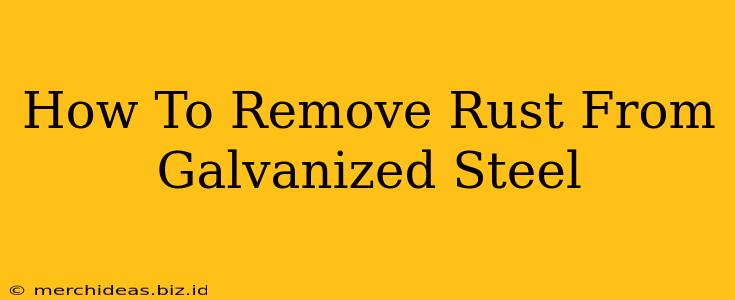Galvanized steel, with its protective zinc coating, is known for its durability. However, even this robust material can succumb to rust over time, especially in harsh environments. This comprehensive guide will walk you through effective methods to remove rust from your galvanized steel, restoring its appearance and extending its lifespan. Knowing how to remove rust from galvanized steel is crucial for maintaining various items, from tools and furniture to roofing and siding.
Understanding Rust on Galvanized Steel
Before diving into removal methods, it's important to understand why rust forms on galvanized steel. While the zinc coating prevents rusting, it eventually wears away through abrasion, weathering, or damage. Once the zinc layer is compromised, the underlying steel is exposed to the elements, leading to rust formation. Identifying the extent of rust damage is the first step in choosing the appropriate removal technique. Light surface rust requires different treatment compared to deep, pitted corrosion.
Factors Affecting Rust Formation:
- Exposure to Moisture: Prolonged exposure to rain, humidity, or saltwater accelerates rust development.
- Environmental Pollutants: Acid rain and other atmospheric pollutants can corrode the zinc coating.
- Abrasion and Scratches: Physical damage to the surface exposes the steel beneath, making it vulnerable to rust.
Methods for Rust Removal from Galvanized Steel
Several methods exist for removing rust from galvanized steel, each with its own level of effectiveness and suitability depending on the severity of the rust.
1. Wire Brushing: For Light Surface Rust
For light surface rust, a simple wire brush—either manual or powered—can be effective. This method is relatively quick and requires minimal tools. Remember to wear appropriate safety gear, including gloves and eye protection. The wire brush removes loose rust particles, leaving a cleaner surface. However, it's not suitable for heavily rusted areas.
2. Sandpaper or Sandblasting: For Moderate Rust
Sandpaper, in various grits, offers a more controlled approach to rust removal. Start with coarser grit for heavy rust and gradually move to finer grits for a smoother finish. This method is ideal for smaller items or areas where precision is required. For larger surfaces, sandblasting provides a more efficient solution, but requires specialized equipment and safety precautions.
3. Chemical Rust Removers: For Stubborn Rust
For stubborn or heavily pitted rust, chemical rust removers are often the best option. These commercially available products contain acids or other chemicals that dissolve rust. Always follow the manufacturer's instructions carefully, as these chemicals can be corrosive. Ensure adequate ventilation and wear protective gear. After treatment, thoroughly rinse the surface with water. Some popular options include phosphoric acid-based converters. Remember that this method may also slightly etch the zinc coating.
4. Electrolysis: For Advanced Rust Removal
Electrolysis is a more advanced method used for heavily rusted galvanized steel. It involves immersing the rusted item in an electrolyte solution and applying a low-voltage electric current. This process effectively removes rust without damaging the underlying metal. However, it requires specific equipment and some technical knowledge.
Protecting Galvanized Steel After Rust Removal
Once the rust is removed, it's crucial to protect the galvanized steel from future corrosion.
Post-Treatment Protection:
- Zinc-Rich Primer: Applying a zinc-rich primer provides a protective layer, similar to the original galvanization.
- Paint or Coating: A layer of high-quality paint or protective coating further enhances the protection. Choose a coating formulated for outdoor use if applicable.
- Regular Cleaning and Maintenance: Regularly cleaning and inspecting the galvanized steel helps prevent future rust formation.
By following these steps, you can effectively remove rust from your galvanized steel and preserve its longevity. Remember to always prioritize safety and choose the appropriate method based on the severity of the rust damage. Regular maintenance is key to preventing future issues.
